What Is Playing Out From The Back?
In modern times, football has increasingly become a possession game.
Even though different teams utilise different tactics, the general tendencies have been shifting towards a more ball-dominant approach which has been popularised by clubs like Barcelona, Manchester City or Bayern Munich.
The backbone of a possession-based style still lies in playing out from the back.
While simple in its definition, this specific tactic is extremely difficult to execute and carries a certain risk with a high margin of error.
Of course, just as with everything else in football, there is no single best approach to playing out from the back and it all depends on personnel, systems and opposition faced.
With that being said, this tactical analysis will provide you with a tactical theory on playing out from the back, highlighting some of the main concepts behind these tactics.
Similarly, the analysis will focus on the different roles and profiles this strategy requires to succeed.
Let’s begin.
Basic concepts Of Playing Out The Back
Before we proceed with the detailed tactical analysis of what each of the players is supposed to do to make playing out from the back possible, we have to set the basic concepts every system should follow when trying out these tactics.
All players can be coached to play a certain way, especially if that process is started early enough in their careers.
However, it is also true that profiles play a huge role in certain players fitting certain systems.
Just as you wouldn’t deploy an immobile and technically poor striker in a false nine role, you also wouldn’t choose a centre-back tandem and a goalkeeper who are bad with their feet for a possession-heavy system.
So player profiles play a huge role when trying to play out from the back.
It is, of course, a joint effort and the whole team needs to be coordinated well to successfully navigate their way out of their half.
The second very important thing is making the pitch big.
The bigger the pitch is when you have the ball, the more space you have to exploit and the more space the opposition needs to cover.
That’s why you’ll always see centre-backs spreading as far as possible and full-backs and wingers often hugging the touchline higher up the field.
And this is also where team shape comes into play.
Fluidity and thinking on your feet are important but it is also important that every player maintains the shape set in possession.
Playing out from the back is based on every player knowing he’ll have a passing option available in a set sequence.
Of course, we can never predict everything in football but players who are a part of the best systems already know how, where and when their teammates will move or reposition.
Next is involving the goalkeeper.
For the playing out from the back tactics to be at their best, the goalie needs to be considered an outfield player.
There are plenty of reasons why which we’ll discuss further down the line of this tactical analysis but the goalkeeper often being the first player to start the sequence is key.
By starting the build-up in your box and inviting the opposition to come to you, you eliminate one player on the other side – the opposition goalkeeper.
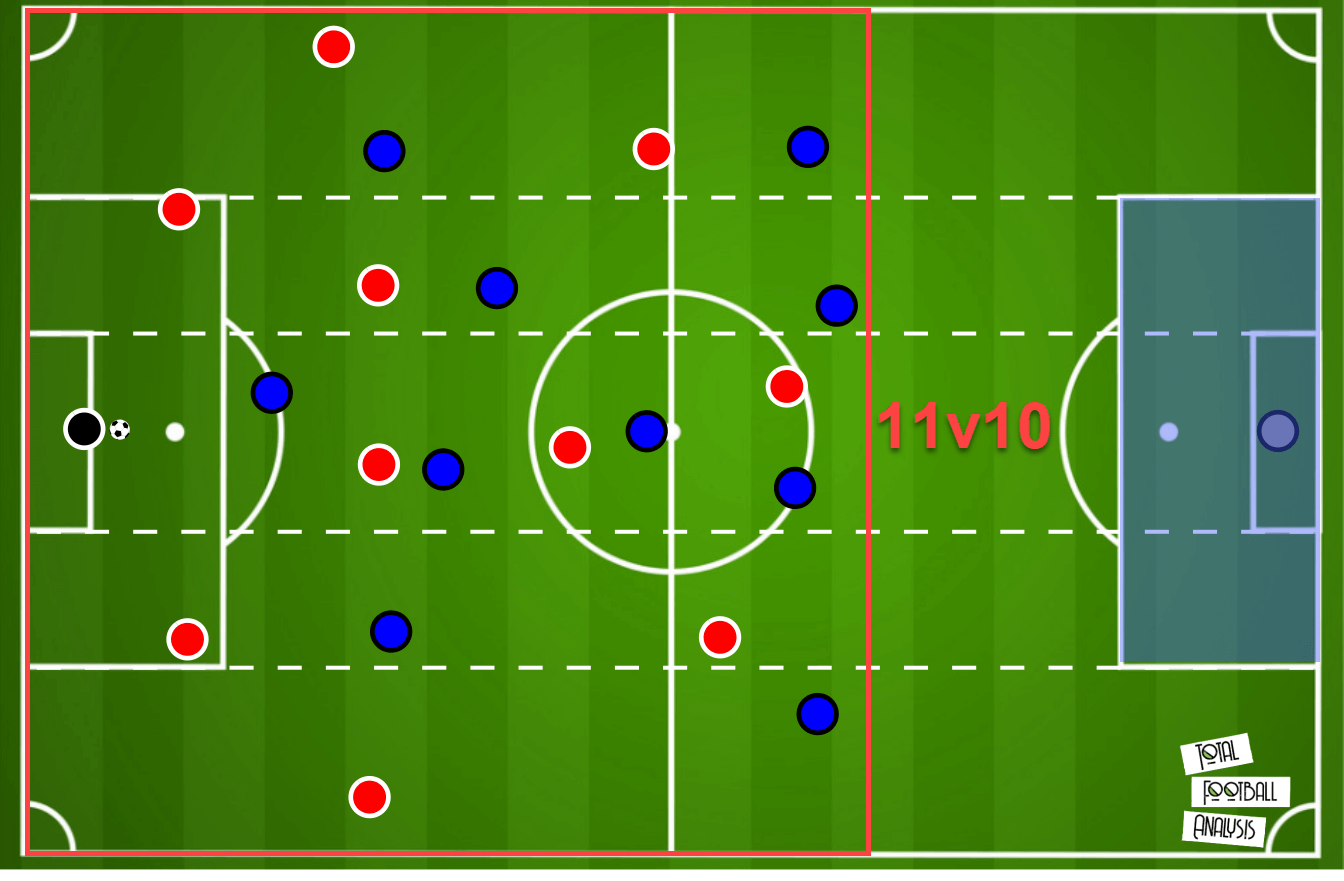
Now the game is already tilted in your favour as it essentially becomes a 11v10 battle and superiorities are guaranteed if executed properly.
Finally, patience is needed.
Modern football is very attacking-minded and every move needs to be aesthetically pleasing and positive.
However, that is far from the most efficient way to play.
Sometimes, a forward passing option won’t be immediately available, especially if you’re playing against a well-organised defensive block that effectively expands into a high press.
Just being comfortable passing backwards or recycling the ball until an opening appears is incredibly potent in such situations.
Don’t ignore the benefits of it.
Now that we have the basics covered, let’s move on to some specific tactics and setups.
The backline
The backline holds the key to successfully playing out from the back, that much is clear.
It all starts with the defenders and the goalkeeper as they are the first line to engage in an attempt to achieve progression.
We’ve touched upon specific player profiles earlier in this tactical theory but it truly is a key aspect of these tactics.
Liverpool’s Virgil Van Dijk is perhaps one of the best modern examples of a complete centre-back who fits the bill, the same as Manchester City’s Ederson personifies the ideal ball-playing goalkeeper.
Technical quality on the ball is essential but so is spatial awareness, proper body orientation and general footballing IQ.
So let’s start with the goalkeeper.
We’ve already mentioned how by playing out from the back you guarantee superiorities in a 11v10 battle.
But you must know how to utilise it.
Of course, some teams will press you high and some will let you establish possession around the halfway of the pitch so your approach largely depends on that.
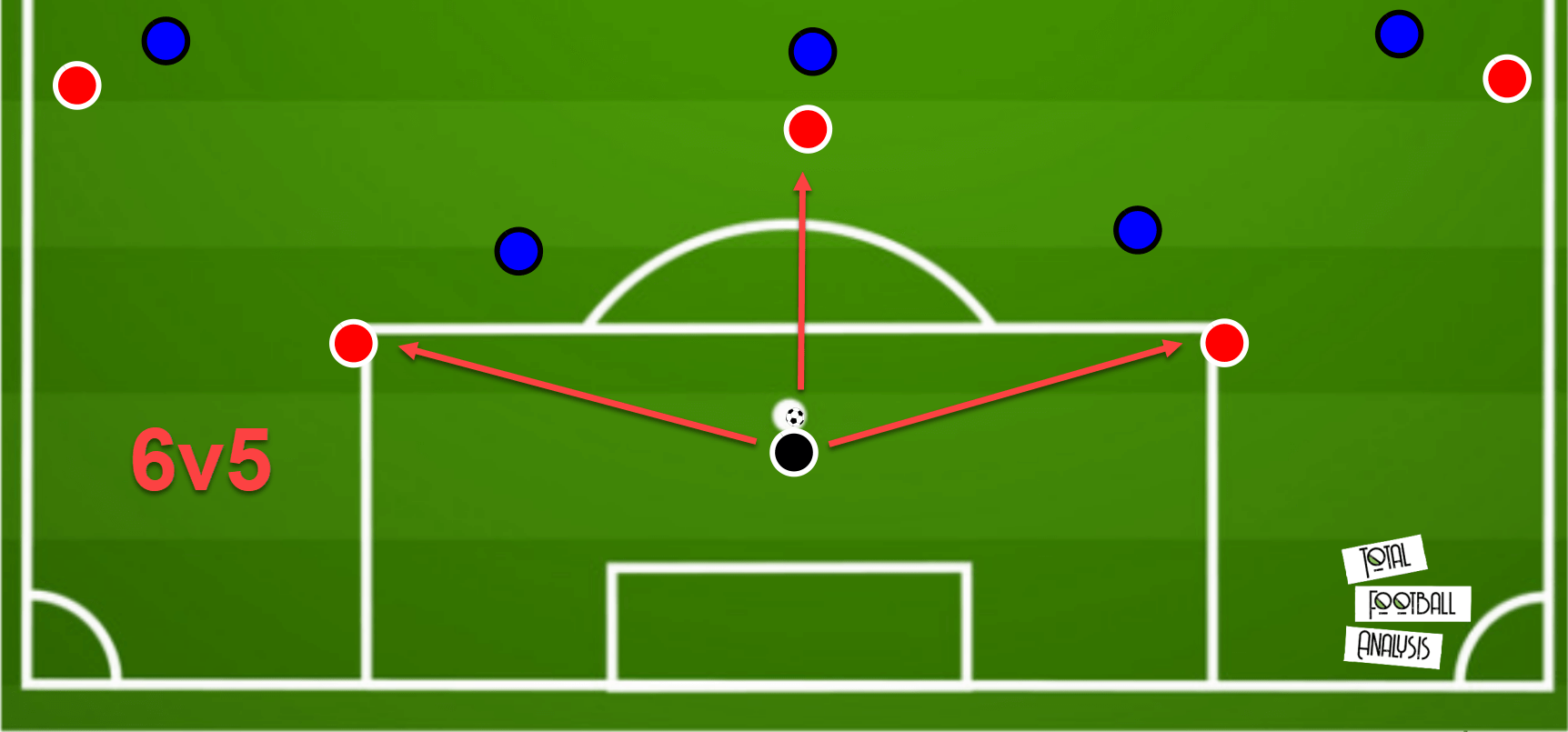
Generally, teams will look to proactively punish systems that are based on playing out from the back since despite having many benefits, it’s still an overall very risky approach.
One mistake often yields a great chance for the opposition to strike.
However, as you can see above, including the goalkeeper gives you much better odds at escaping the press.
The goalie won’t always guarantee numerical superiority in the first phase of build-up as that depends on how many players the opposition commits to the press.
In our situation above, the red team have established a 6v5 superiority due to successfully incorporating their goalie into the sequence.
Another very important point is to eliminate predictability by ensuring the distances between the goalkeeper’s likeliest options are equal.
Notice in the image how the opposition has to keep track of both centre-backs and the dropping pivot since all three channels are equally accessible to the goalkeeper.
This also brings us to another huge benefit of playing out from the back: space creation.
By inviting the opposition deeper, space starts to appear between the lines.
As their backline inevitably pushes up, they will be vulnerable to runs in behind.
Equally, if they stand their ground and stay pinned by the forwards, space will appear between the lines.
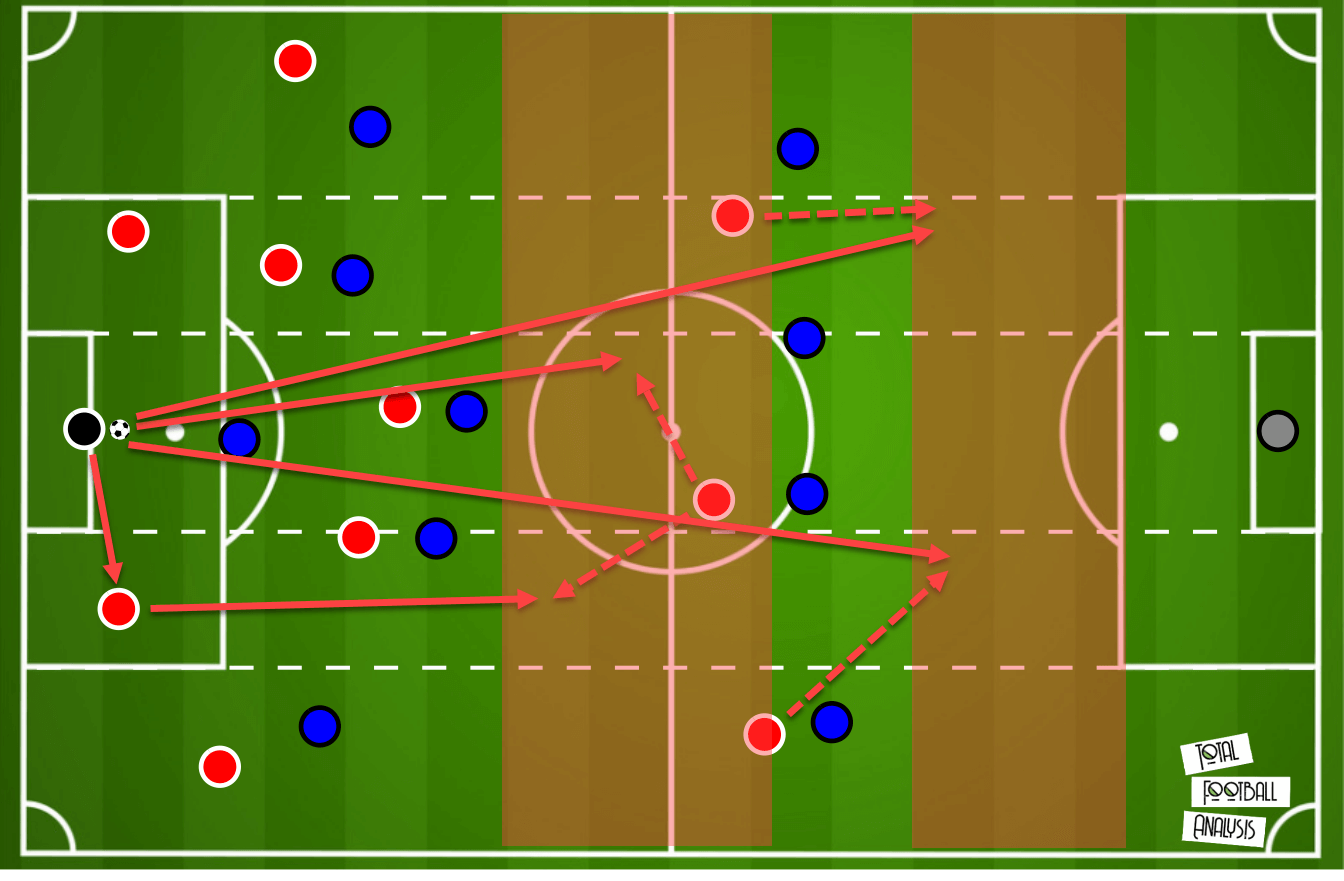
And that’s why it’s essential to have the right profile of players in those situations.
The goalie now has multiple options in front of him but all require technical quality on the defenders’ part.
He can go short to one of the centre-backs who then advance play with vertical passes or he can go long to a dropping #9 or the wingers who are attacking space higher up.
Crucially, we shouldn’t confuse playing out from the back with playing short combination football.
These tactics are all about generating superiorities anywhere on the pitch.
If the superiority of any kind is achieved in the first line, then short combinations are preferred.
If, however, we’ve achieved it higher up, deploying a long ball is equally effective and still counts as playing out from the back.
Take the following graph as an example.
By inviting the opposition to push forward in a 433 system, gaps start to appear in two places that are only accessible via long passes.
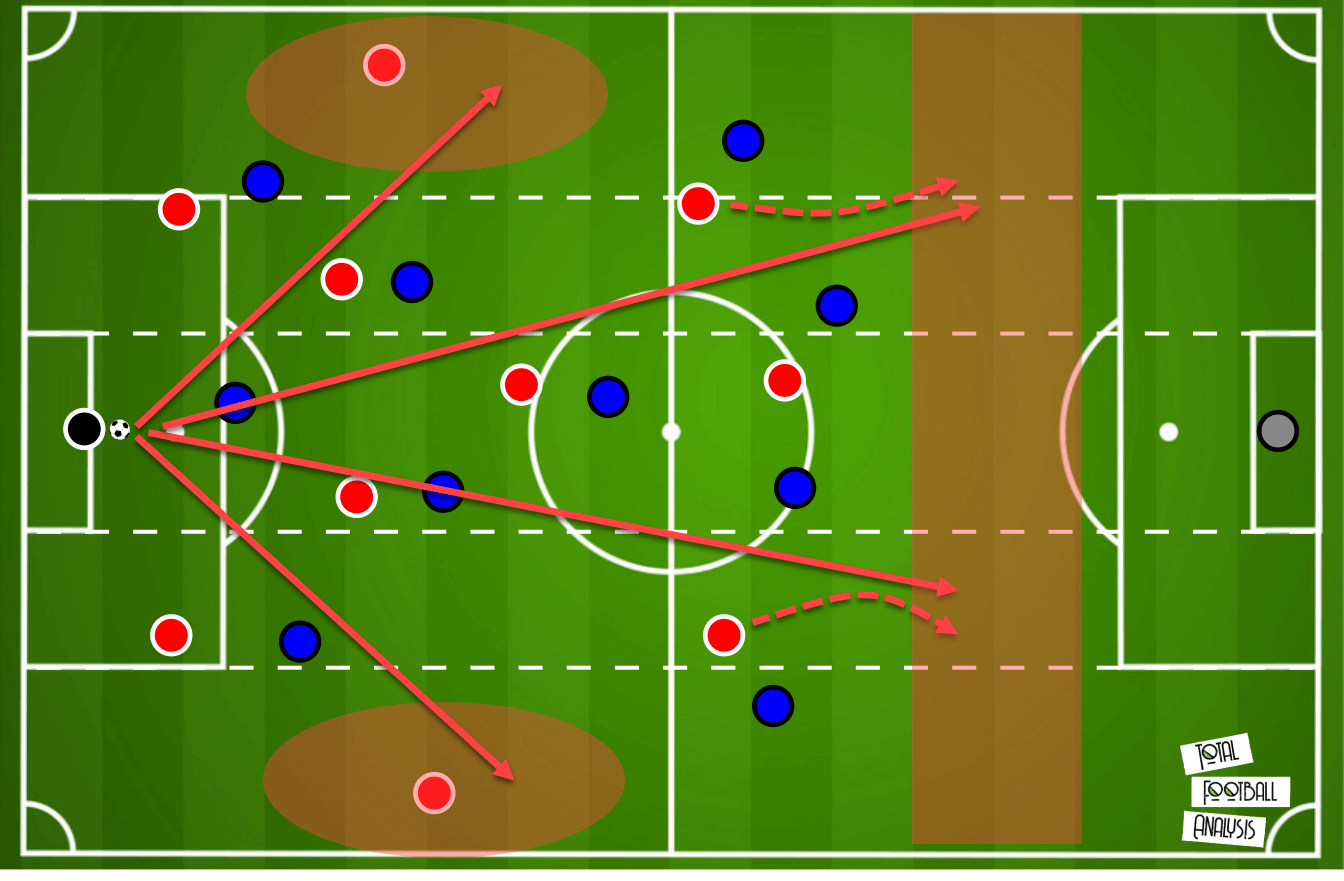
The first one is again the space behind the opposition backline.
Naturally, we come back to specific player profiles as the wingers need to actively attack space and have at least some pace for this approach to be effective.
Equally, the goalkeeper needs to be good enough with his feet to find the target.
But playing a pass to the full-backs might be an easier option as it gives the goalie a lesser margin for error.
On the other hand, it’s much easier to collapse on a full-back who’s hugging the touchline than on a sprinting winger and losing the ball in the opposition’s half is not nearly as damaging as losing it in your half.
However, if the goalie has been successfully used to generate superiorities, even the best-pressing squads will struggle to effectively collapse.
Take Manchester City vs Liverpool as an excellent example below.
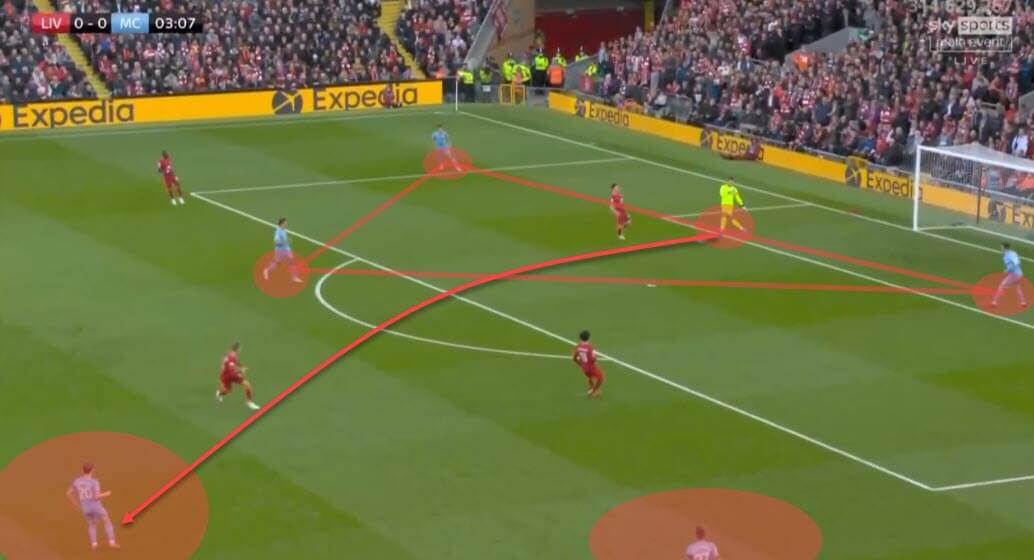
Pep Guardiola’s team has invited The Reds deeper and by matching them man for man, Liverpool have left gaps higher up the pitch.
Ederson being one of the best ball-playing goalkeepers on the planet can easily execute the sequence you can see above.
But we also have to discuss the role the centre-backs and full-backs play in such tactics.
Above, they didn’t touch the ball because they were being closely marked by the opposition but even if they had, it gives the team in possession options to advance.
Of course, again, this is highly dependent on the opposition’s approach to defending.
Will they actively close down the man in possession or will they back off and prioritise staying deep and compact? That decision then ultimately moulds the attacking sequence of the team in possession.
We’ll explore both instances in the following examples.
The first graph below depicts both options when the centre-back is on the ball.
If the opposition press highly, that means the centre-back has to pass the ball or beat the marker via dribbles to advance play.
However, once the opposition presses, space inevitably appears behind their backs that can be accessed.
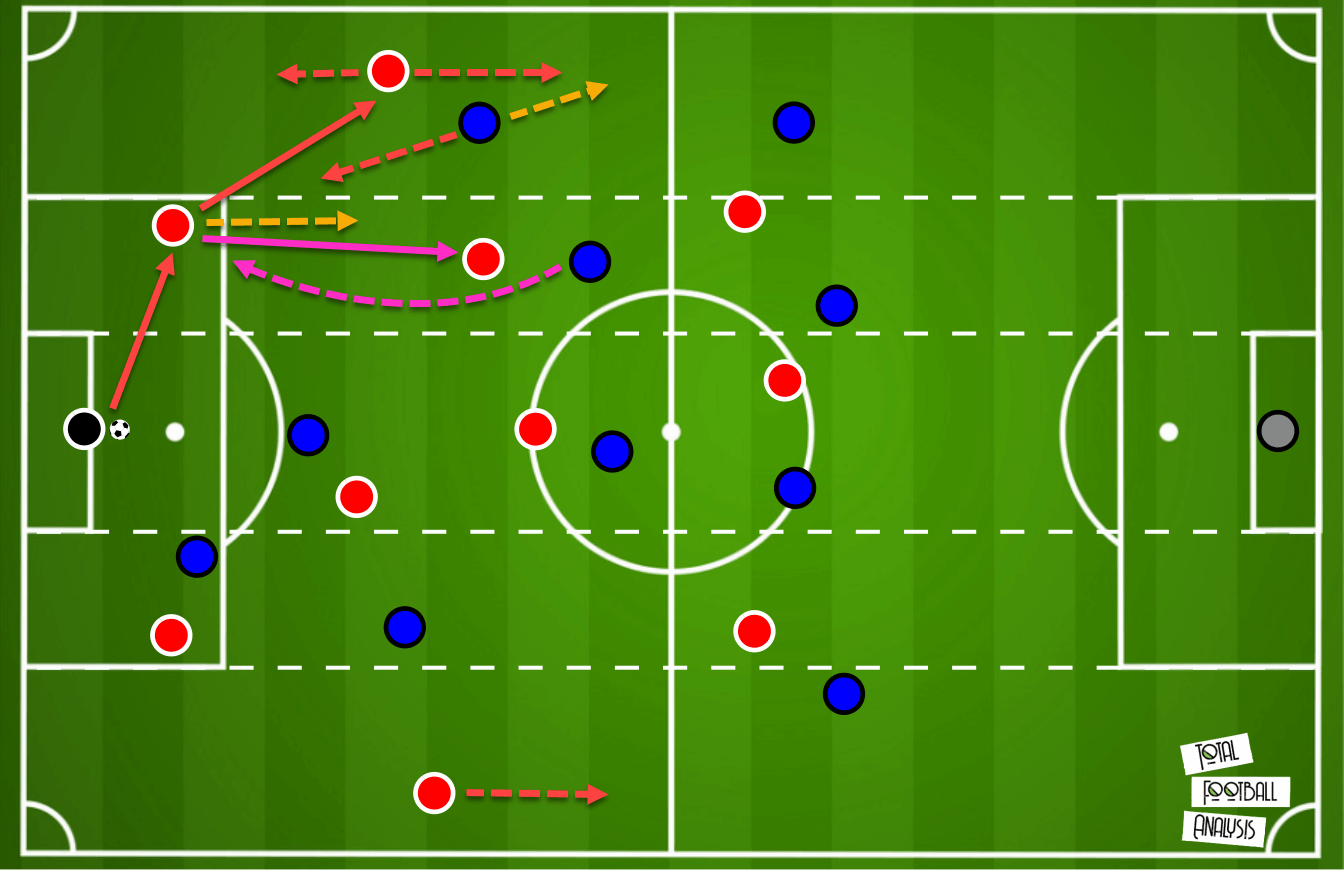
So if the wide player presses the centre-back, the full-back becomes the free man.
Equally, if the midfielder presses, that leaves his counterpart free.
We can conclude that in the face of the press, space will always appear somewhere else that can be accessed through a combination of movement and passing because the opposition can still effectively use their cover-shadow to block two players with one marker.
Let’s see how that works in a real in-game example.
Once again we’ll come back to Manchester City and Liverpool as they are a team that excels at playing out of a press pitted against probably the best pressers in world football.
But notice how The Citizens easily access the wide areas as soon as Sadio Mané decides to press Kevin De Bruyne.
Since Liverpool opted to block the central channel, Manchester City now has the wide areas accessible.
Action, reaction.
Always.
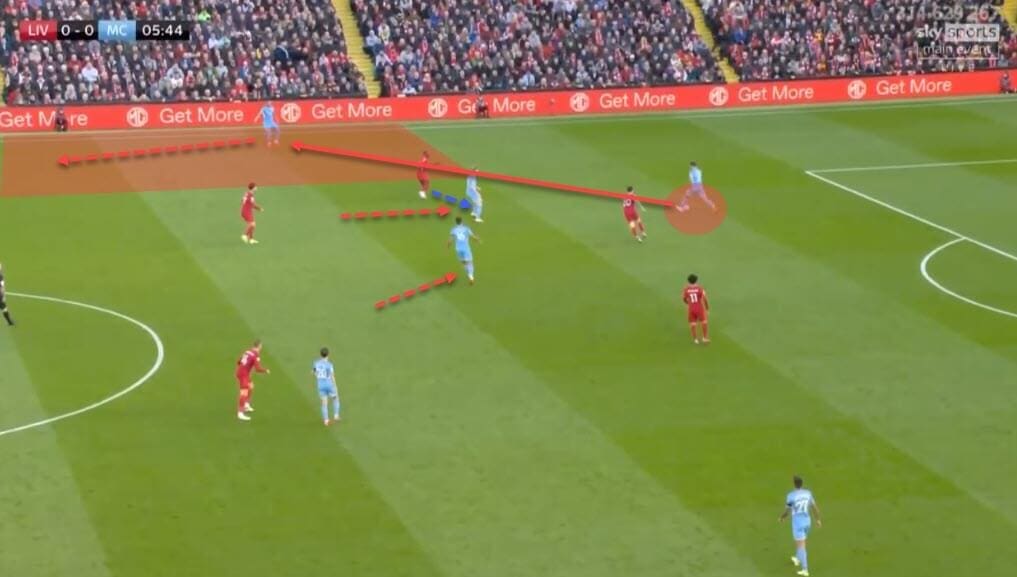
The other outcome is the defending team sitting deep and not contesting the ball higher up the pitch.
In that scenario, the centre-backs are given much more space and time to make their next move and will generally proceed to run with the ball.
Again, not every centre-back is comfortable doing that and if the opposition has done their scouting properly, they will know which one they have to press and which one can be left unmarked in the first phase of build-up.
But teams like Barcelona base their approach on good ball-playing defenders and will aim to release them into space whenever possible.
Take this sequence against Atlético Madrid as an example.
Even at their lowest point and with the game ultimately being comfortably lost, the Catalans still exhibited some clean progression tactics involving superiorities and movement.
We can see how the goalkeeper is used to establish numerical superiority in the first line and that also enables Ronald Araújo, a player who’s generally deemed not as good on the ball, to run in possession and exploit the newfound space.
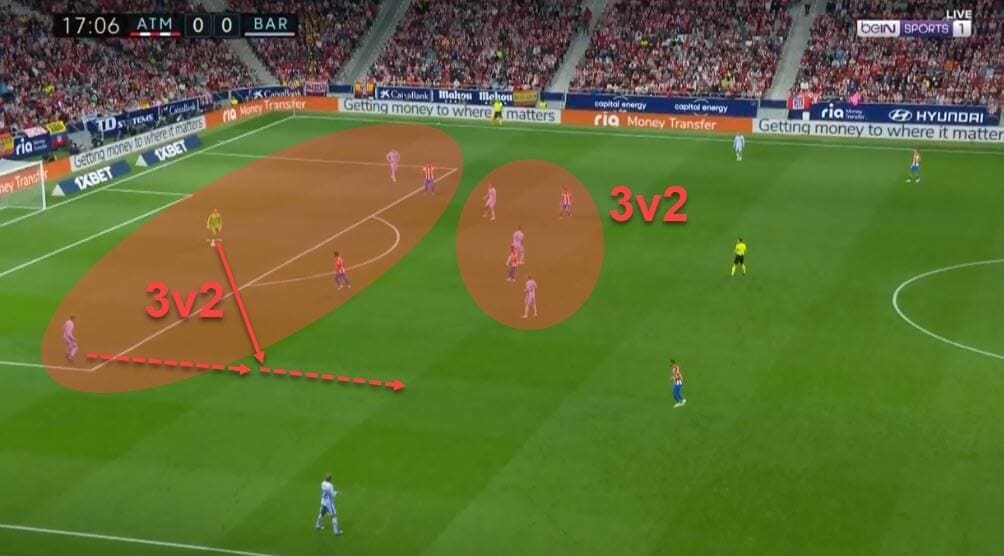
This goes to show you how a good tactical setup can still be utilised even if the player profile is not necessarily ideal.
A good structure aims to mask the players’ deficiencies while highlighting their strengths.
But apart from achieving superiority in the first line, Barcelona have also done the same in midfield, which is the perfect segue to the next big section of our tactical analysis.
The midfield and forward line rotation
Just as the backline holds the key to playing out from the back, the other two lines, namely the midfield and the forward line, are equally as important.
Their movement and coordination give the defenders viable options to access and achieve progression through and failing to open passing channels will usually result in a loss of possession.
So when it comes to playing out from the back, the midfielders and forwards are usually tasked with off the ball actions to assist the build-up.
Of course, pivots will often drop deep enough to start the progression themselves and some forwards, like Paris Saint-Germain’s Lionel Messi, will take it upon themselves to start and finish such sequences too.
Let’s start this section of the tactical theory by looking at the midfielders in particular.
Generally, we can talk about systems that utilise single or double pivots, which then conditions the ensuing action.
But in both cases, movement to create passing channels and different angles is crucial.
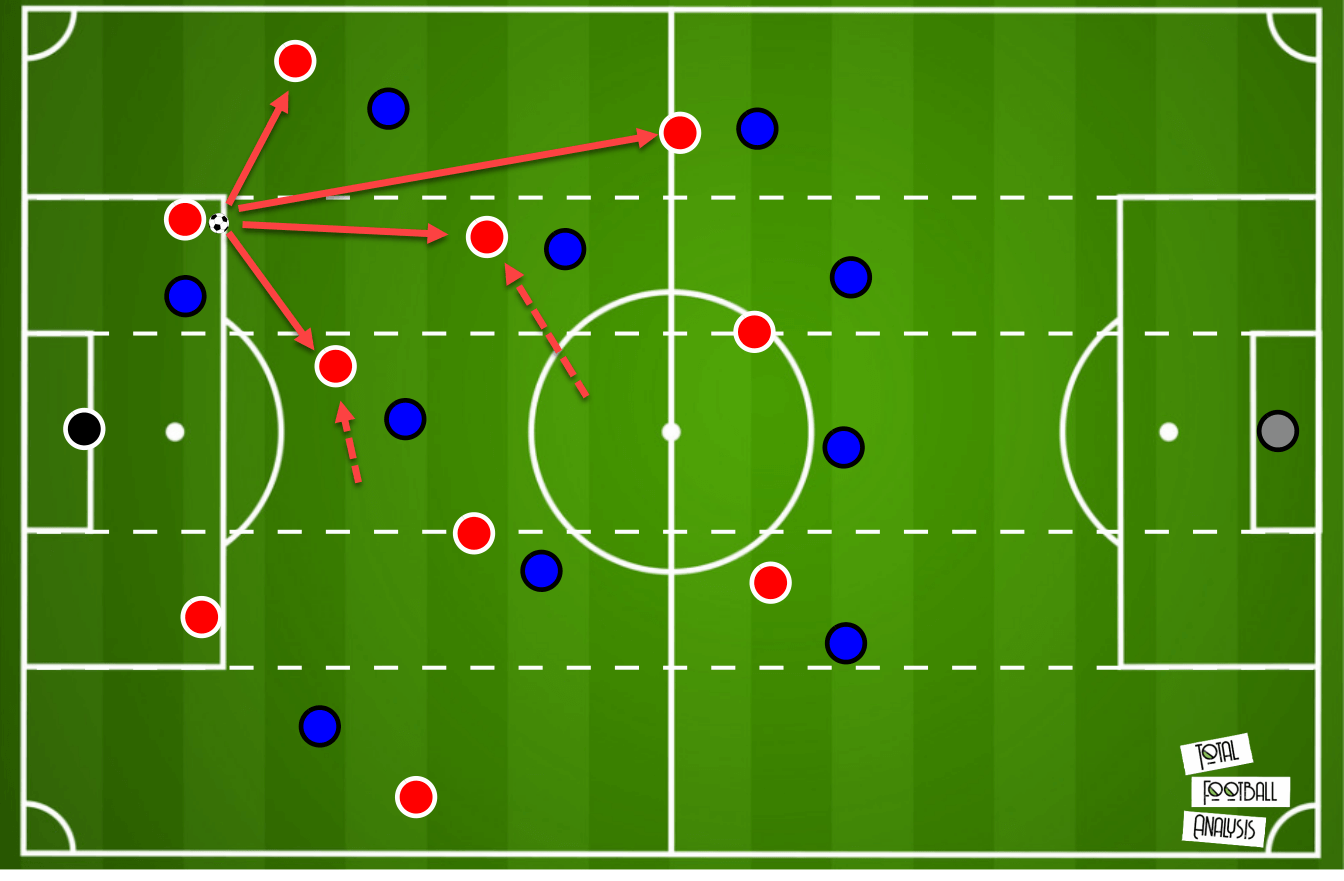
Notice in the image above how two midfielders move towards the ball side of the pitch to open more options for the centre-back in possession.
Had they stayed still, they would’ve been far easier to mark and progression would’ve been far more difficult to achieve.
Another thing to understand is that not all movement is done with an attempt to receive the ball.
In the same example, we can see multiple options for the centre-back down the left side but also a 3v2 overload on the right as well as winger isolation higher up the pitch.
These overload to isolate tactics are quite common for teams who are trying to build up from the back as it gives them additional outlets to exploit in possession.
Of course, with the single pivot, it’s very common to see them dictate the game and set the tempo.
With an extra midfielder (or two) dropping deep, it gives the team in possession a higher chance of ensuring numerical superiority.
If the goalkeeper is unable to access the free players, the dropping #6 is generally a player with enough technical quality to do it instead.
You can see his passing options in the graph below.
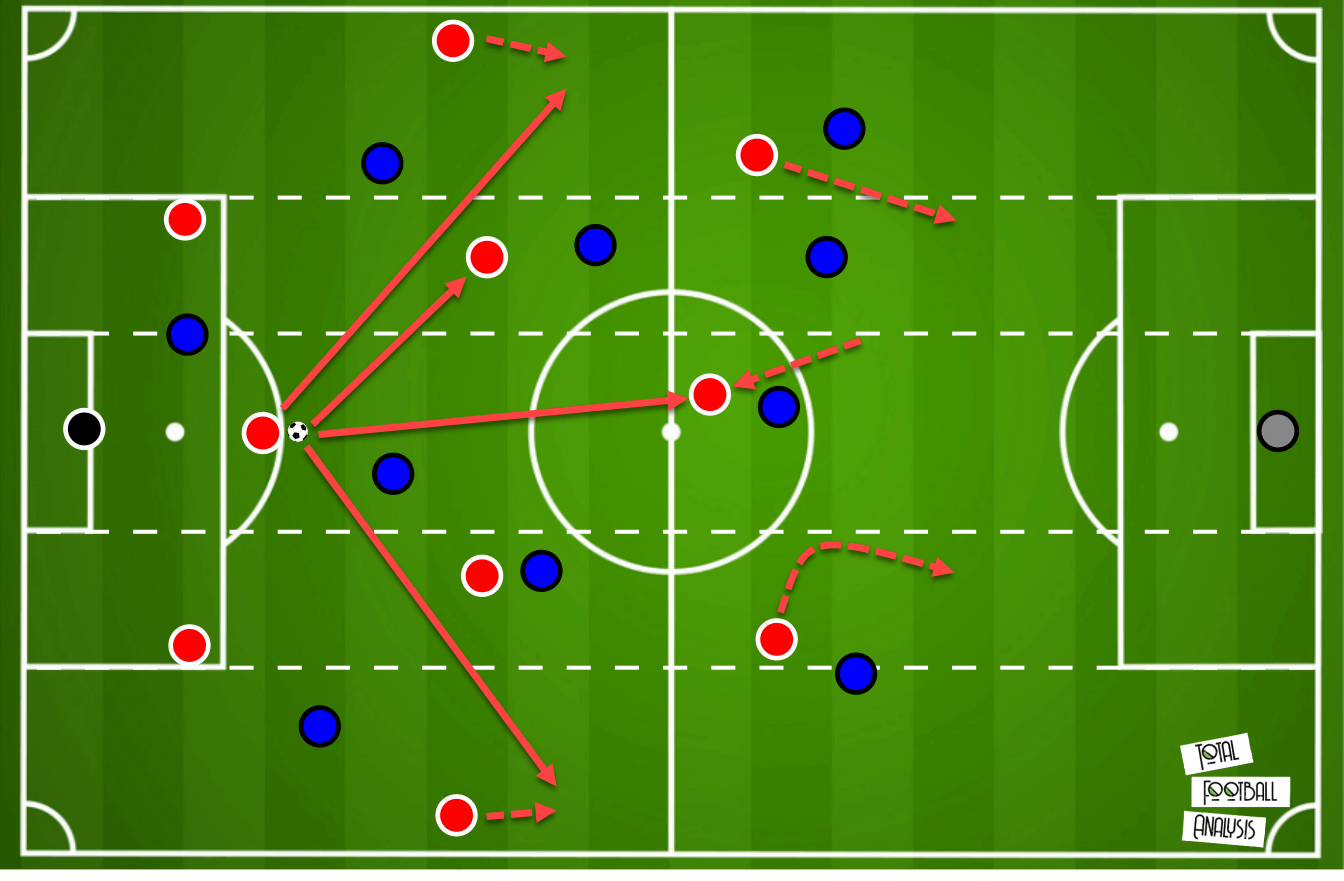
The same principles apply here with the pivot as with the goalkeeper earlier.
Numerical superiority is achieved so what remains is the execution by either sending the ball into the free full-backs or the wingers who are attacking space.
Another very common sequence involves a dropping #9 who can act as a link-up player and/or as a target-man for long balls from the backline.
In both cases, player profiles play a crucial role.
Someone like Tottenham Hotspur’s Harry Kane is very good at doing the link-up part as a very modern striker and someone like Inter Milan’s Romelu Lukaku is your more traditional target-man with insane hold-up play.
Let’s see how such profiles can support the process of building up from the back.
Below is an example in which the opposition has first been invited to press higher and then once gaps appear between the lines, Kane can drop deeper and be used as a link-up following a long-range pass from the back.
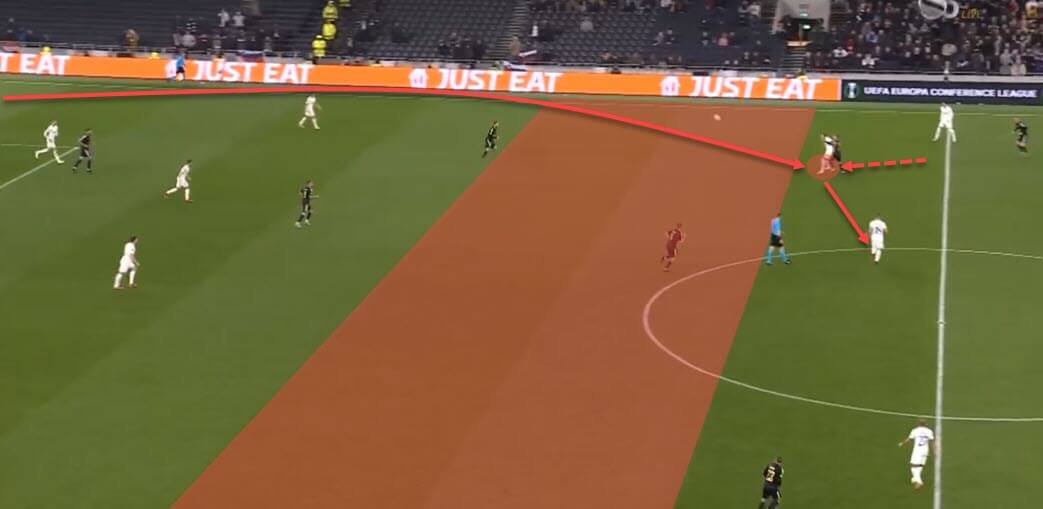
He first accesses the newly-created space, controls the ball briefly and then lays it off to the nearest teammate who’s in a good position to advance the play.
You could argue that the opposition is nowhere near compact enough here and that’s very true but the sequence still shows us the principles we’re trying to analyse quite nicely.
The thing we also have to understand is the fact that all of these principles we’re talking about here are connected.
Players across different lines need to work together and it’s never simply about what one player or one line does but rather how the others react and what they do to make playing from the back easier and ultimately successful.
Take the following sequence with a double-pivot as an example.
The goal is to release the full-back into space but initially, he is being marked by the opposition.
By dropping two pivots, however, the goalie can first access one of them since the opposition forward is overloaded (2v1), which in turn invites pressure and subsequently frees up the right-back.
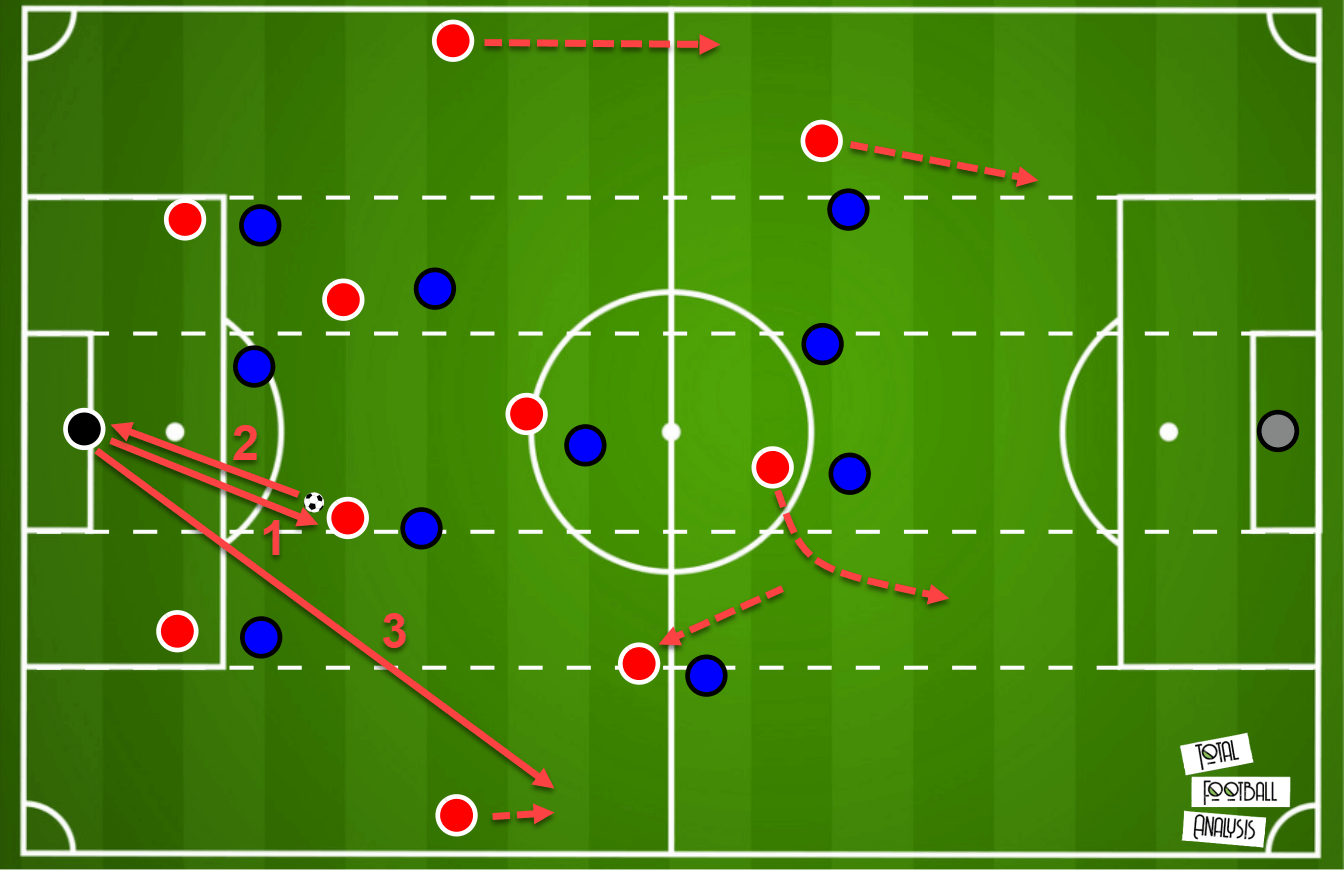
The ball goes into the midfielder first, then back to the goalie and finally into the full-back for the initial progression sequence to be complete.
However, that’s not nearly the only thing to note here.
When one full-back drops deeper to receive the pass in the face of the press, the other bursts forward.
Similarly, one winger drops deeper to either present himself as an option for the goalie, to overload the defender who’s trying to mark him or simply to pull that same defender out of the structure, thus creating an opening for the striker and the other winger to attack space.
Everything is connected and every action begets a reaction.
Let’s go back to Barcelona for a moment again with our next example.
You can see them forming a double pivot just ahead of the backline to ensure a numerical superiority and support the build-up from the back.
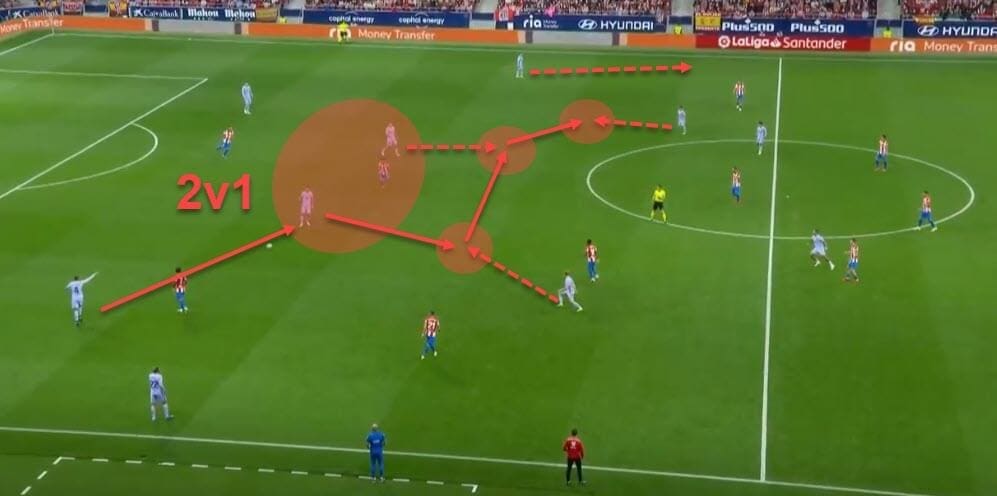
The opposition pivot is overloaded (2v1), which wouldn’t be the case had Barcelona deployed a single pivot.
One winger and full-back drop to assist the build-up and progression becomes very smooth.
Even for a struggling team, the Catalans cut through their sturdy opposition with ease.
But ultimately, what this does is more of the same thing we discussed earlier in our analysis.
By dropping more players deeper and inviting the opposition to come to them, space is created elsewhere on the pitch.
And then, it can be accessed via good movement.
Take this Chelsea example below.
Thomas Tuchel is another very positional coach who bases his tactics on many things we’ve mentioned throughout this piece.
In the following sequence, we see the Blues invite Southampton to press higher and then they drop their advanced players deeper into the vacated space.
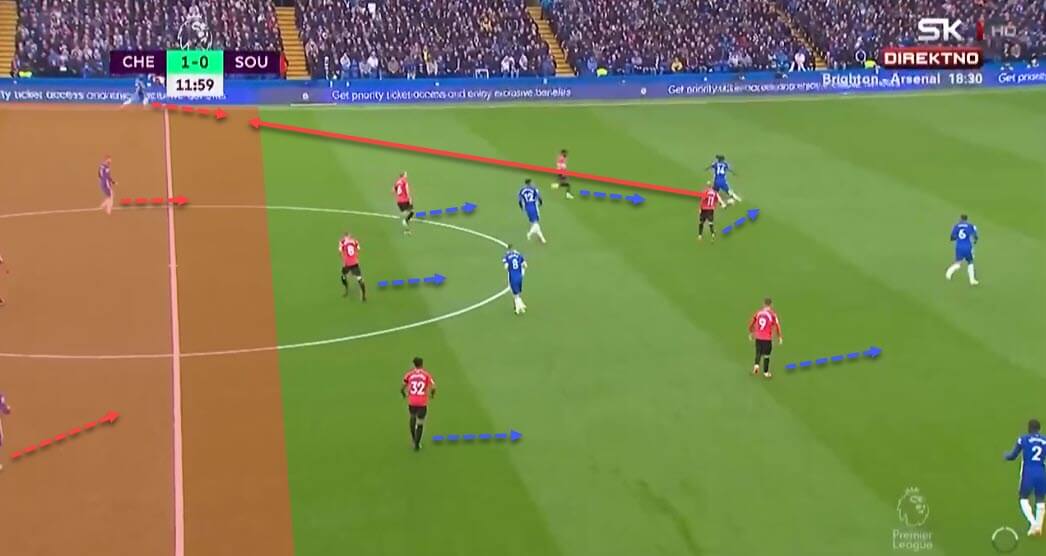
A simple pass towards the wide areas eliminates the compact but narrow pressing squad of the Saints and achieves easy progression for Chelsea.
Final remarks
Of course, there will always be more variations, more unique scenarios and more examples, tasks and roles in these kinds of tactics.
Playing out from the back is a very complex strategy that is based upon high-risk, high-reward principles, some of which were explained in this tactical theory piece.
But just as we’ve seen football evolve from a more direct approach to the one most big teams are utilising nowadays, we can expect the same thing to happen once more in the future.
No doubt playing out from the back has its perks but how long will it enjoy the popularity and the success it is currently enjoying?
That remains to be seen but whatever happens next, we’ll be there to analyse it either way.

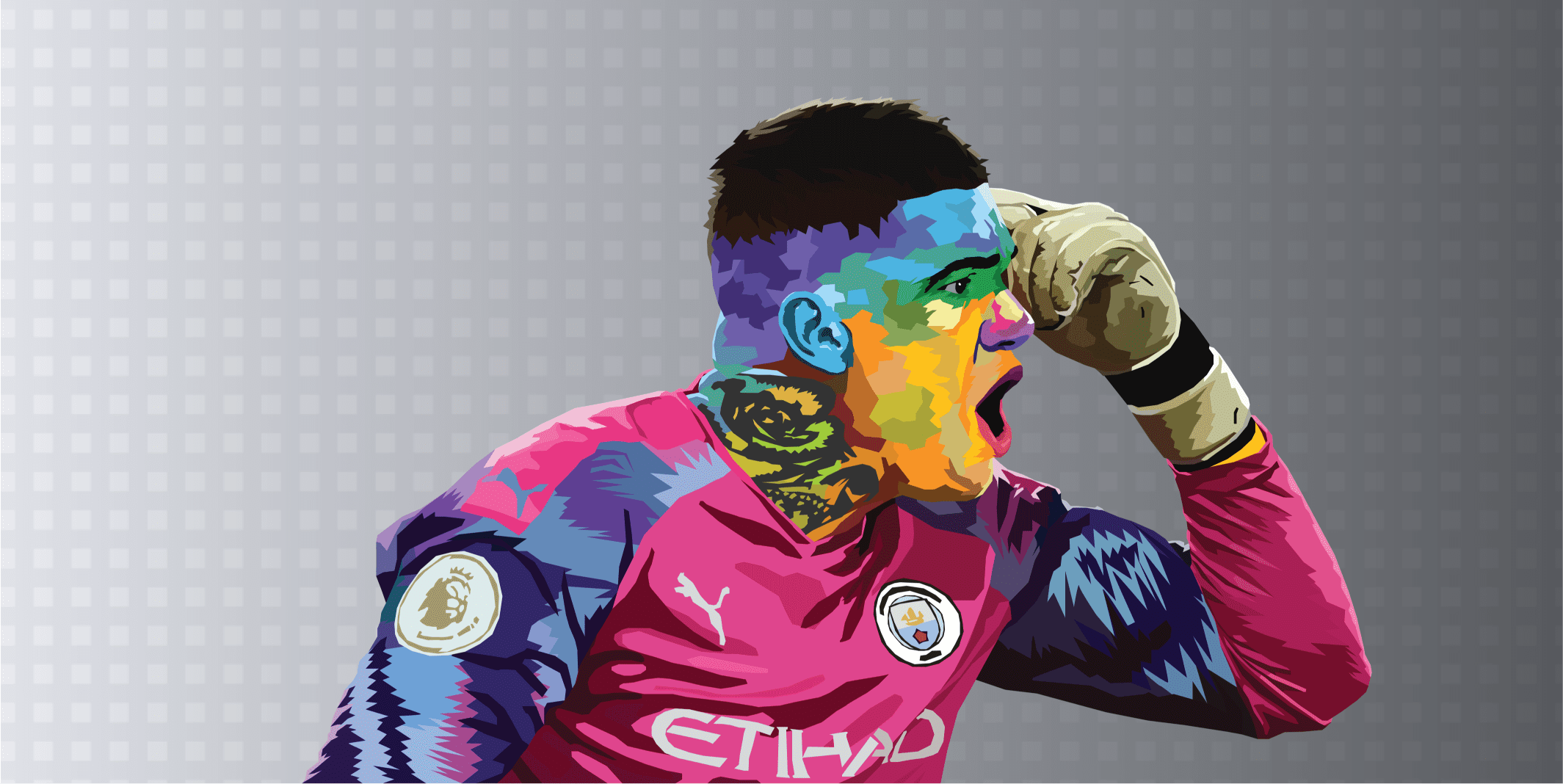




Comments